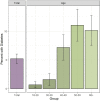Diabetes Epidemiology Among Adults in Port-au-Prince, Haiti: A Cross-Sectional Study
- PMID: 35282460
- PMCID: PMC8913034
- DOI: 10.3389/fendo.2022.841675
Diabetes Epidemiology Among Adults in Port-au-Prince, Haiti: A Cross-Sectional Study
Abstract
Introduction: Diabetes mellitus is a chronic noncommunicable disease associated with death and major disability, with increasing prevalence in low- and middle-income countries. There is limited population-based data about diabetes in Haiti. The objective of this study was to assess the prevalence of diabetes and associated factors among adults in Port-au-Prince, Haiti using a population-based cohort.
Methods: This study analyzes cross-sectional enrollment data from the population-based Haiti Cardiovascular Disease Cohort Study, conducted using multistage sampling with global positioning system waypoints in census blocks in the metropolitan area of Port-au-Prince, Haiti. A total of 3,005 adults ≥18 years old were enrolled from March 2019 to August 2021. We collected socio-demographic data, health-related behaviors, and clinical data using standardized questionnaires. Diabetes was defined as any of the following criteria: enrollment fasting glucose value ≥ 126 mg/dL or non-fasting glucose ≥ 200 mg/dL, patient self-report of taking diabetes medications, or study physician diagnosis of diabetes based on clinical evaluation.
Results: Among 2985 (99.3%) with complete diabetes data, median age was 40 years, 58.1% were female, and 17.2% were obese. The prevalence of diabetes was 5.4% crude, and 5.2% age standardized. In unadjusted analysis, older age, higher body mass index (BMI), low physical activity, low education were associated with a higher odds of diabetes. After multivariable logistic regression, older age [60+ vs 18-29, Odds Ratio (OR)17.7, 95% CI 6.6 to 47.9] and higher BMI (obese vs normal/underweight, OR 2.7, 95% CI 1.7 to 4.4) remained statistically significantly associated with higher odds of diabetes.
Conclusion: The prevalence of diabetes was relatively low among adults in Port-au-Prince, but much higher among certain groups (participants who were older and obese). The Haitian health system should be strengthened to prevent, diagnose, and treat diabetes among high-risk groups.
Keywords: Caribbean region; Haiti; cardiovascular risk factor; diabetes mellitus; epidemiology.
Copyright © 2022 Sufra, Lookens Pierre, Dade, Rouzier, Apollon, St Preux, Préval, Inddy, Metz, Tymejczyk, Nash, Malebranche, Deschamps, Pape, Goncalves, McNairy and Yan.
Conflict of interest statement
RS, JLP, ED, VR OT, JWP, MLM report a grant from NHLBI Q23 R01HL143788. MLM reports a grant from NHLBI D43TW011972, and Fogarty International Center R21TW011693. The funders were not involved in the study design, collection, analysis, interpretation of data, the writing of this article or the decision to submit it for publication. The remaining authors declare that the research was conducted in the absence of any commercial or financial relationships that could be construed as a potential conflict of interest.
Figures


References
-
- International Diabetes Federation . IDF Diabetes Atlas, 10th Edn. [Internet] (2021). Brussels, Belgium. Available at: https://www.diabetesatlas.org (Accessed 2021 Nov 15).
MeSH terms
Grants and funding
LinkOut - more resources
Full Text Sources
Medical

